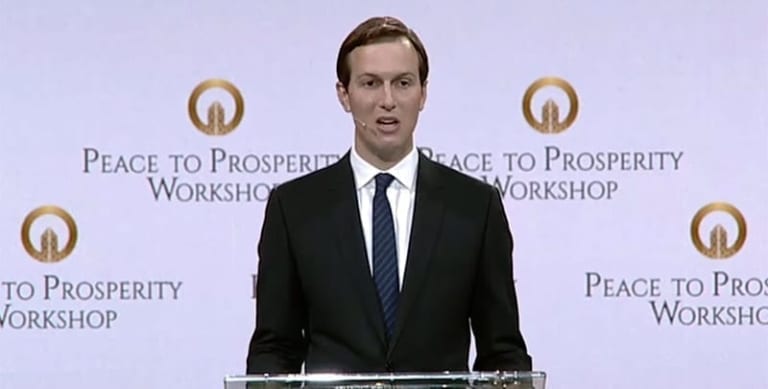
Imagine, if you will, that it is Spring 2017 and you are Jared Kushner, son-in-law of the newly sworn-in American president. He has anointed you special envoy in charge of devising the ultimate deal to bring peace to the Palestinians and Israelis. You are sitting in the members-only Grand Havana Room on the 39th floor of 666 Fifth Avenue in Manhattan. As you contemplate your new political appointment, you look over the opulence of the city of money and watch Wall Street executives smoke Cuban cigars. Suddenly, you get this devilishly creative idea about lifting the Palestinians up from their decades-long poverty. You ask the waiter to quickly get you a pen and paper and you immediately start jotting down elements of a ten-year economic program that will fix their dire situation so that they can finally learn how to govern themselves.
One can easily imagine this scenario when reading the Trump Administration’s Peace to Prosperity: A New Vision for the Palestinian People and the Broader Middle East, announced on June 22. The plan consists of a “vision” about “unleashing” the economic potential of the Palestinians, “empowering” them, “enhancing” their governance, and, through trade and investment, “integrating” their economy with that of the larger Middle East. Specific economic projects and programs are also proposed as essential parts of this vision, with unexplained dollar amounts in grants, loans, and foreign investment. What undergirds the plan’s different elements is the unfortunate, indeed tragic, disregard of the conditions that impede Palestinian development and the willful ignorance of what might help to advance their lot.
It is important to analyze the essential shortcomings in the elements of this so-called “vision.” They clearly expose Kushner and his team as lacking important background and knowledge of basic political economy, development and culture studies, and primarily, the realities of Palestinian life under Israel’s military occupation.
Lecturing about the importance of the Palestinians’ quest for reforms that aid investment and growth, the plan’s writers invoke the examples of South Korea, Singapore, Taiwan, and Japan as states that built modern economies. These countries have surely accomplished economic miracles that made them “Asian Tigers”; however, first and foremost, one must acknowledge that they are independent states, and second, that they realized such economic success by implementing the “developmental state” model of political economy in which the state is the pivotal economic actor and regulator of the economy. In this model, the state and its institutions intervened in regulation and in planning as well as in serving as the conduit for investment in industrial and other sectors.
There are two reasons why it is hard to imagine that this is the model that Kushner and company are advocating. First, there is no independent Palestinian state that can undergo such a development drive. To be sure, no one assessing the Trump Administration’s policies regarding Palestine and Israel thinks that a Palestinian state is in the offing. Further, it is clear that the administration does not consider the Palestinians as independent political or economic actors. Second, it is highly doubtful that the Trump Administration is remotely interested in the development of independent Palestinian state institutions to oversee the American vision of a capitalist economy with a thriving private sector.
The same obtains for the plan’s recommendations about human capital as essential for economic development, entrepreneurship, innovation, and business creation. Again, Kushner’s dreamers want to apply German and Swedish models for producing the next generations of Palestinian business and civic leaders. Perhaps the US team is unaware that there are already plenty of such Palestinians but that they are stymied by Israeli occupation and siege and are prevented from building thriving businesses, let alone organizing their neighborhoods. Moreover, the plan takes a flight of fancy when it talks about creating roads and rail networks without taking into account the scores of Israeli checkpoints and roadblocks on the West Bank that stop people for hours and prevent them from doing the most mundane of life’s activities such as attending a school or university, going to a hospital, accessing their farmland, delivering goods, and attending meetings. The Trump team has conveniently overlooked the 12-year economic blockade of Gaza, a territory where Israeli warplanes regularly create deep craters in neighborhoods and hundreds of thousands of people live a precarious life.
This deliberate disregard of the reality on the ground also applies to the plan’s goal to end electrical power shortages and ensure water safety and wastewater treatment. For decades, Israel has controlled Palestinian life by regulating fuel supplies for power plants, especially in Gaza where electricity has become very scarce. As for water, the planners dismiss the fact that Palestinians are prevented from digging wells on their land to help address their continuing water shortage—and this is while Israel’s illegal settlements on the West Bank enjoy lush gardens and swimming pools. The planners also speak of untreated wastewater as if Palestinians have no problem with exposing their communities to diseases and health risks.
Kushner and his team think that Palestinians should really concentrate on developing their tourism sector and build hotels and food establishments so that the world can visit and spend money there. To them, Gaza would benefit tremendously from developing its coastline so that it can be like Beirut, Hong Kong, Lisbon, Rio de Janeiro, Singapore, and Tel Aviv. What they forget is that these are capitals and cities that have had the opportunity to govern themselves and formulate development plans that serve their citizens. Without an independent Palestinian state, of which Gaza would be an integral part, no tourism can be developed and no tourists are going to flock to the area just because a hotel and a few food establishments may be erected. Gaza today is an open-air prison whose walls hold two million Palestinians as prisoners, disallowed from living a life of dignity and national independence.
What also is ironic in this plan is its insistence on supporting agriculture in the occupied Palestinian territories without paying attention to the fact that Israel applies its eminent domain wherever it wants on Palestinian-owned land. Israeli settlers routinely, indeed daily, uproot Palestinians’ trees at will, most of the time under the protection of Israeli soldiers. The plan also encourages the development of a housing market—while Israeli occupation authorities refuse even to issue building permits to Palestinians. The same constraints apply when it comes to encouraging manufacturing and the exploitation of natural resources in the West Bank and Gaza.
The plan’s prescriptions for Palestinian regional integration through trade and investment are yet another example of the tone-deaf thinking in the Trump Administration regarding the reality of Israel’s military occupation of Palestinian land. The plan wants Palestinians to do what countries such as Singapore, Poland, Egypt, and Tunisia previously accomplished in promoting capital accumulation and investment. Again, and in contrast to Palestine, the countries mentioned (in addition to Dubai, which enjoys economic independence within the United Arab Emirates) enjoy full independence and exercise sovereignty over defined territories and borders under their control.
These and other matters the plan addresses, such as having access to education and health care, improving governance and the legal structure, supporting women and the youth, developing efficient municipal services, and reforming public institutions, among others, suffer from the same neglect: Kushner and his team have cleverly chosen not to take account of the repressive conditions of the Israeli occupation today.
Finally, the plan’s attention to providing funding to the Palestinians in Jordan, Lebanon, and Egypt smacks of one of the economic vision’s most nefarious intents: to bribe host countries to settle their Palestinian refugee communities so that the right of return to Palestine is forfeited. Any reader of the plan and observer of the Trump Administration’s orientation to Israeli and Palestinian affairs over the last two and a half years knows that Kushner and his father-in-law are not fundamentally interested in helping the Palestinians. The funds they have allocated for the three countries are simply to be used for settling about four million Palestinian refugees, with the goal of ending demands for Palestinian self-determination.
With a price tag of $50 billion, presumably paid by oil-rich Arab countries, Kushner’s Peace to Prosperity is in essence a plan to liquidate the Palestinian cause once and for all. If this plan gets implemented, Palestine as a national cause—and the Palestinians’ dreams of their inalienable national rights—would disappear into thin air, just like the cigar smoke in the Grand Havana Room at 666 Fifth Avenue.

